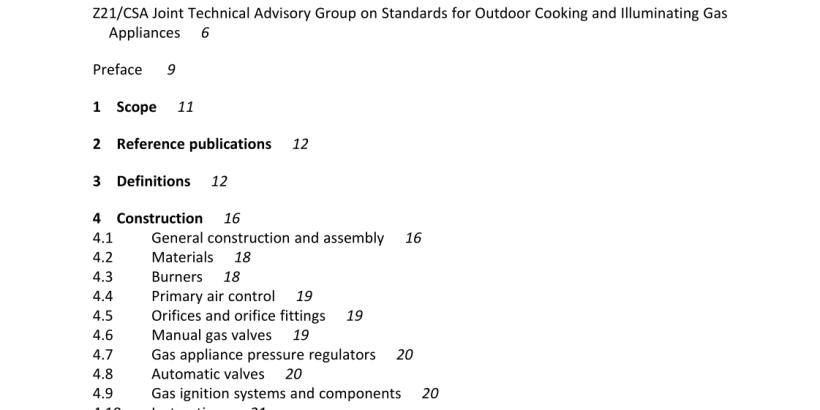CSA ANSI Z21.42.13-2018 pdf download.Gas-fired illuminating appliances
Automatic valve for gas appliances — an automatic or semi-automatic device consisting essentially of a valve and operator that controls the gas supply to the burner(s) during normal operation of an appliance. The operator may be actuated by application of gas pressure on a flexible diaphragm, by electrical means, by mechanical means or by other means. Semi-automatic valve — a valve that is opened manually and closed automatically, or vice versa. Baffle — an object placed in an appliance to change the direction of or retard the flow of air, gas-air mixtures, or flue gases. BTU — abbreviation for British Thermal Unit. The quantity of heat required to raise the temperature of 1 pound of water 1 °F. Burner — a device for the final conveyance of the gas, or a mixture of gas and air, to the combustion zone. Injection (Bunsen) type burner — a burner employing the energy of a jet of gas to inject air for combustion into the burner and mix it with the gas. Atmospheric injection type burner — a burner in which the air at atmospheric pressure is injected into the burner by a jet of gas. Luminous or yellow-flame burner — a burner in which secondary air only is depended on for the combustion of the gas. Burner head — that portion of a burner beyond the outlet end of the mixer tube which contains the ports. Burner valve, gas — a manually operated valve which permits control of the flow of gas. Candle, international — the international unit of luminous intensity, being the light emitted by five square millimeters of platinum at the temperature of solidification. Candle, standard — a unit of luminous intensity approximately equal to the intensity of light from a 7 / 8 – inch sperm candle burning at the rate of 120 grains per hour. Chimney, lamp — a glass tube placed around a flame or mantle. Combustion — combustion, as used herein refers to the rapid oxidation of fuel gases accompanied by the production of heat or heat and light. Combustion chamber — the portion of an appliance within which combustion occurs.
Diaphragm type automatic valve — a device consisting essentially of an automatic valve, actuated by means of the application of gas pressure upon a flexible diaphragm. Electric type automatic valve — a device actuated by electrical energy for controlling the gas supply. Excess air — air which passes through the combustion chamber and the appliance flues in excess of that which is required for complete combustion. Flame check — a gauze, grid, or any other portion of the burner assembly used to avert a flash back. Flue gases — products of combustion and excess air. Flue outlet (vent) — the opening provided in an appliance for the escape of the flue gases. Foot-candle — a unit of illumination, being the direct illumination on a surface everywhere one foot from a uniform point source of one international candle. Heating value (total) — the number of British Thermal Units produced by the combustion at constant pressure of 1 cubic foot of gas when the products are cooled to the initial temperature of the gas and air, when the water vapor formed during combustion is condensed, and when all the necessary corrections have been applied. Input rating — the gas-burning capacity of an appliance in Btu per hour as specified by the manufacturer. Appliance input ratings are based on sea level operation and need not be changed for operations up to 2,000 feet elevation. For operation at elevations above 2,000 feet, input ratings should be reduced at the rate of 4 percent for each 1,000 feet above sea level. Latching type valve — a manual gas valve which requires at least two separate actions or movements to turn on the valve, as for example, pushing in on the valve handle to “unlatch” the valve before the valve handle can be rotated to turn on the gas. CSA ANSI Z21.42.13-2018 pdf download
